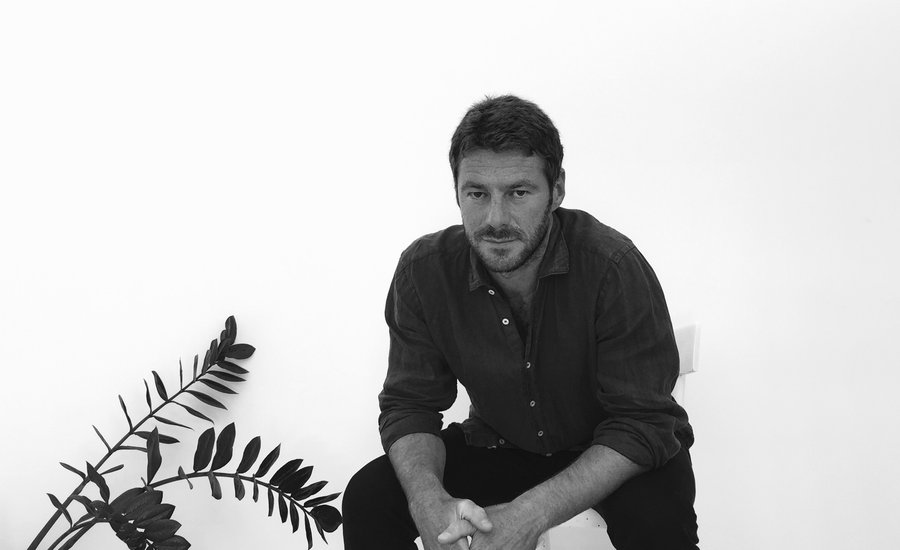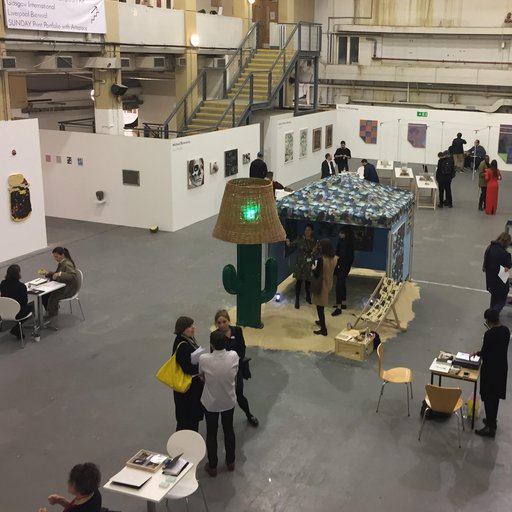Art fairs are hardly a rarity these days, meaning new upstarts need to work especially hard to distinguish themselves from the herd.
With this in mind, Turin, Italy’s DAMA , founded by the gallerist Giorgio Galotti and set to open its first edition on November 3rd, does its best to check off all the boxes: a unique exhibition space (the fresco-covered baroque palace Palazzo Saluzzo Paesana ), a tightly curated program (featuring just 10 super-cool emerging galleries from around the world, each allowed to bring works from only one or two of their artists), and an interesting, accessible, and unexpected location (the city of Turin itself). Add to this an extensive performance program and Galotti’s insistence on elevating the art fair from its commercial roots and you have an event designed to be a new staple for fans of today’s youngest and most innovative artists.
Here, Galotti explains how he transformed a 300-year-old palace into a contemporary art site, what we really mean when we use the word “fair,” and why Italian collectors are a cut above the rest. Be sure to browse the works here using our exclusive online preview, and visit the Palazzo yourself from November 3-6 in Turin.
What was the impetus behind starting DAMA in the first place?
We focused our reflection on the position of today’s young galleries and emerging artists, starting from the displays of traditional art fairs. In my opinion they’re no longer attractive, for many reasons.
Most galleries are white cubes—if you look at their installation photography, it seems like watching variations of the same exhibition. It also happens during art fairs, where the exposure alongside more than 200 participants and thousands of artists doesn’t help collectors any more. Lastly, let’s think about the participation costs undertaken by the galleries just to present their works for a few days. In the free era of the World Wide Web, that's insane. We therefore need something different, easier, customized, and selected—something the web can’t replace.
There’s no shortage of art fairs around the world—what sets yours apart from all the others?
First of all, we understand the real meaning of the word “fair.” The historical definition is usually tied to special religious occasions. In England, since at least 1293, animal trading—as in horses, lambs, and ewes—is mentioned under the word “fair.” In modern times, the concept of “fair” reaches all business categories, including art. But do artworks and their artists deserve to be treated as cows, restricted into a paddock to express their research? The first intention was to separate the word “fair” from DAMA, instead building a show dedicated to a small group of international galleries to present their artists in correspondence with an historical venue.
I have the feeling that most of the international art fairs or organizations we’re talking about are not particularly interested in discovering talents or in getting to know new galleries. The proliferation of art fairs is just connected to sales—now everyone knows how to behave in a traditional fair, what to show to sell quickly, what’s the perfect moment to catch relevant people, and how to manage their time.
With DAMA, we are going on the opposite direction. We’re inviting guests to live in a Baroque palace from the 1700s, complete with original frescos made by the Italian painter Domenico Guidobono, and then watch how participating artists and galleries deal with this historical dialog. That means that we could find that an artwork perfectly matches the room allocated to it, or we can witness the contrast between the 1700s atmosphere and a 2016 artwork.
I’m glad you brought up the fair’s location. What can you tell me about this very unique building and the reasons behind selecting it?
Torino was the first capital of Italy and the last royal residency—imagine how many private, historical buildings Torino can offer. After visiting several antique venues around the center, we decided to launch this project in the Palazzo Saluzzo Paesana because of its history and location—it’s adjacent to Piazza Savoia, where the obelisk symbolizing Piedmont’s pride stands. Right under the obelisk, the Town Hall buried a crate containing two issues of “Giornale del Popolo,” printed in 1850, with articles regarding the construction of the obelisk itself, valuable coins, a kilo of rice, a bottle of Barbera wine, and breadsticks made in Turin.
The fair will host only ten galleries, each showing only one or two artists—with such a small number of booths, how do you choose who gets in? What do you look for in an art fair booth proposal?
We started a dialogue with some friends with the purpose of finding an alternative way to present our artists, so we decided to send invitations to some good emerging galleries that we believed shared our goals. Some of them have been enthusiastic about the idea of presenting their artists in relation with that location. Artists and galleries received in advance the images and sizes of each room they will occupy, meaning about 90% of the works are site-specific. For this reason, the role of curators has been crucial at this stage.
Tell us more about the fair’s curators, Lorenzo Balbi and Domenico De Chirico. What are their backgrounds and what do they bring to the table?
Both of them are fully involved in the international art world. Many people know Lorenzo Balbi for his role at Fondazione Sandretto Re Rebaudengo—he is the curator of their Young Curators Program, were every year a selection of international emerging curators are invited to stay in Italy for few months to meet Italian artists and visit their studios. At the end of the program, the curators are able to present an exhibition in the Foundation’s exhibition space. You can understand how this program is important for the Italian art system, which is one of the reasons why Lorenzo has decided to present a small selection of Italian emerging artists developed in the spaces in between the rooms. I’m curious to see how it will work.
Domenico De Chirico has an independent curatorial background. He’s curated dozens of exhibitions for new and established international galleries. He’s the perfect figure for this role due for many reasons, especially his personal relationships with gallerists and confidence with the artists. He is a tireless worker. I hope this event will help both of them grow within their positions in the future.
What does the DAMA’s Live program consist of, and how does relate to the rest of the fair?
Thanks for this question—sometimes it seems like performances are used to break moments or to create appointments during the exhibition’s days. On this occasion, the program has been conceived of to present some “live” works, so we have structured it by thinking about the spaces within the Palazzo.
We will host two performances, one during the opening day by Benni Bosetto, and another one by Flavio Favelli on Saturday night, during Torino Art Night. Furthermore, each day we will be presenting three other works: on Thursday an audio installation by Valentina Vetturi, on Friday a complex work by Luca Resta that includes a book he has written for DAMA together with a sound installation, and on Sunday a work by Elena Mazzi. On Saturday afternoon we will have a session of screenings curated by Kabul Magazine, an emerging curatorial platform.
Turin has a long history as a cultural center—what’s the contemporary art scene like? How do you see this event fitting into Turin’s legacy?
In my opinion, Torino is the best Italian city for contemporary art. Castello di Rivoli was the first Italian museum dedicated to contemporary art, and this year it’s been linked to the GAM Museum under the direction of Carolyn Christov-Bakargiev, who was also the artistic director of the last Documenta. So many art spaces were born here, including Fondazione Merz, Fondazione Sandretto Re Rebaudengo, Museo Ettore Fico, PAV, and Camera, the first center for photography. Overall, they’re some of the best galleries we have in Italy.
Furthermore, new independent festivals are coming out this year during Artissima and Club to Club week including like NESXT, dedicated to non-profit spaces, and Torino Graphic Days. We are in touch with all these organizations—some of them are our partners—and we are all working hard to give the city its deserved leading position in Italy.
For those of us that don’t know, how would you characterize Italian collecting culture? What quirks or concerns should a dealer understand when selling to visitors to your fair?
Italy has a long history of collectors, from the Pope’s patronage of arts and the Royal family’s commissions, to the birth of the Arte Povera movement in Torino. Italian collectors are considered among the most interesting in the world, because many of them are not collecting in a shallow way. Our history is strong, and when an artist arouses the interest of an Italian collector, it means a lot. You know better than me how collectors in the United States have intensely extended the concept of a “collection.” But this has also created confusion about the meaning of the word “collector.” Nowadays, we have the perception that if someone buy a painting they automatically turn into a collector. From my point of view, in that moment they remain just a buyer. In Italy, we are trying to rebuild an intimate dialog, and DAMA was born to develop this conversations.
What’s next for you and DAMA?
We are looking forward to opening this edition for now. Afterward, we’ll be focusing on how to improve the project. We would like to create a real network for galleries, offering them an virtual exhibition for 365 days. Normally, fairs open and close within a week. We would like to help galleries of DAMA’s network continue their promotion and this dialog with collectors all the year long with a dynamic website. We’ve already started a dialog with a good technical partner to help us to translate this into reality.
























